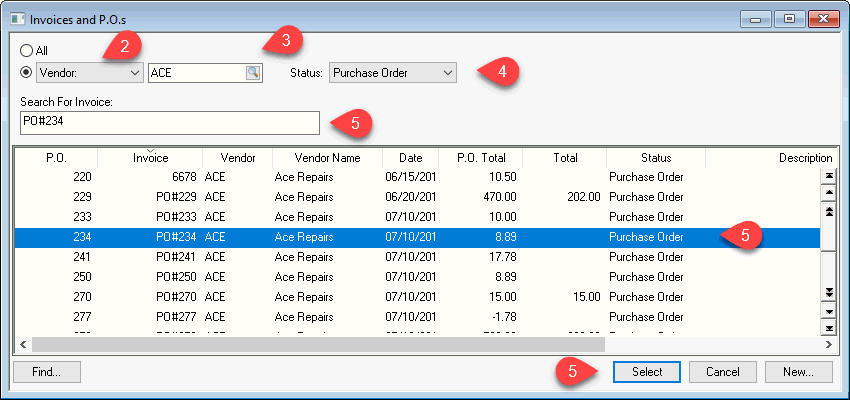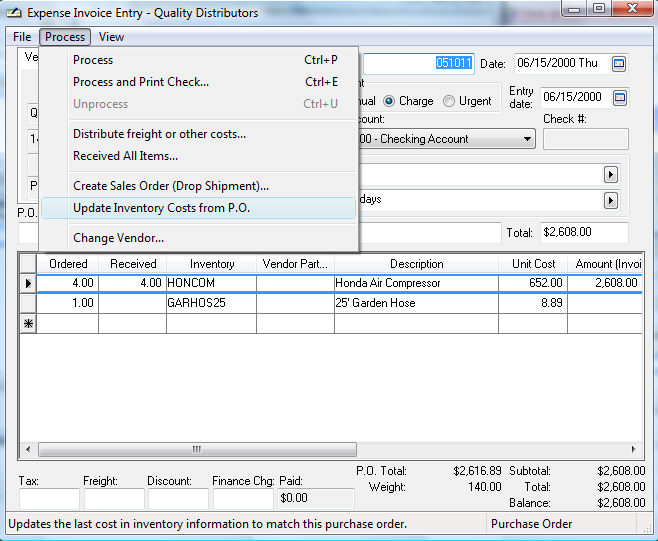A purchase order is used to identify the quantity and cost of the products that are being ordered. If the product count in the Received column within the purchase order reads zero, the products are recorded in inventory as ordered, but the purchase order does not change the total on-hand inventory count.
The following instructions focus on receiving product within the purchase order dialog. (An alternative Receiving Dialog that allows the user to create back orders before the product is invoiced can be accessed by selecting from the main EBMS menu.) Complete the following steps to receive items using the purchase order dialog:
-
Select Expenses > Invoices and P.O.s from the main EBMS menu to open the following dialog and set the Status to Purchase Order:

-
Select the All option to list all purchase orders or select one of the following query options:
-
Vendor: To query all purchase orders from a specific vendor.
-
Ship To Customer: Query purchase orders that are being shipping to a specific customer. Review Special Orders and Drop Shipment Overview for more details on the Ship To Customer setting.
-
Pay To Vendor: Query purchase orders based on the Pay To vendor setting.
-
-
Select the appropriate vendor or customer associated with the purchase order.
-
Search or select a purchase order to open a purchase order dialog as shown below. (Because purchase orders can be processed into invoices, this dialog is called an Expense Invoice Entry.)

-
Enter the amounts that are being received into the Received column. Counts can be entered using a barcode scanner. (Review Entering Barcodes for instructions to pre-configure barcodes or to create a product by scanning a new barcode.)

-
Go to Process > Receive All Items in the header menu to populate the Receiving column with the balance. Use Ctrl + Alt + A as a keyboard shortcut for this action. This value may be restricted to the ordered quantity by setting the option. Review Limit Over-Assignment to limit quantity shipped to the amount ordered.
-
The Received Date for each line that is being received will be set with today's date. Review Estimated Time of Arrival (ETA) Date for information on how the receiving date can be used to enhance the receiving process.
-
Right-click on any purchase order line and select Unfulfilled Sales Orders from the context menu to view the sales order.
-
Complete the following two steps to update the inventory information in the inventory pricing tab. This step is necessary to print inventory price labels from the purchase order with updated pricing.
-
Go to Process > Update Inventory Costs from P.O. from the main purchase order menu to update the last Cost value within Inventory > Count tab. This is necessary only if the pricing is derived from the last cost using a formula. Review the Inventory Pricing section of the Inventory documentation for more details. The last Cost value is updated when the invoice is processed, so this step is not necessary if the purchase order has been processed into an expense invoice.

-
Run any of the following price label reports found in : Inventory Labels from Invoice, Inventory Sheet Labels from Invoice, and Product Labels from Invoice with Link.
-
These steps can be very useful to verify that all items have been received since the number of labels will match the quantity on the P.O. Review Barcodes & POS Tools Overview for more barcode details.
-
NOTE Processing the purchase order into an invoice will add the item(s) to the inventory Count and remove them from the Purchase Orders Ordered and Purchase Orders Received values on the inventory count tab. Purchase orders will not post any information to the General Ledger. To post any information to the G/L, an invoice must be processed. Review the Processing an Invoice section for details.
